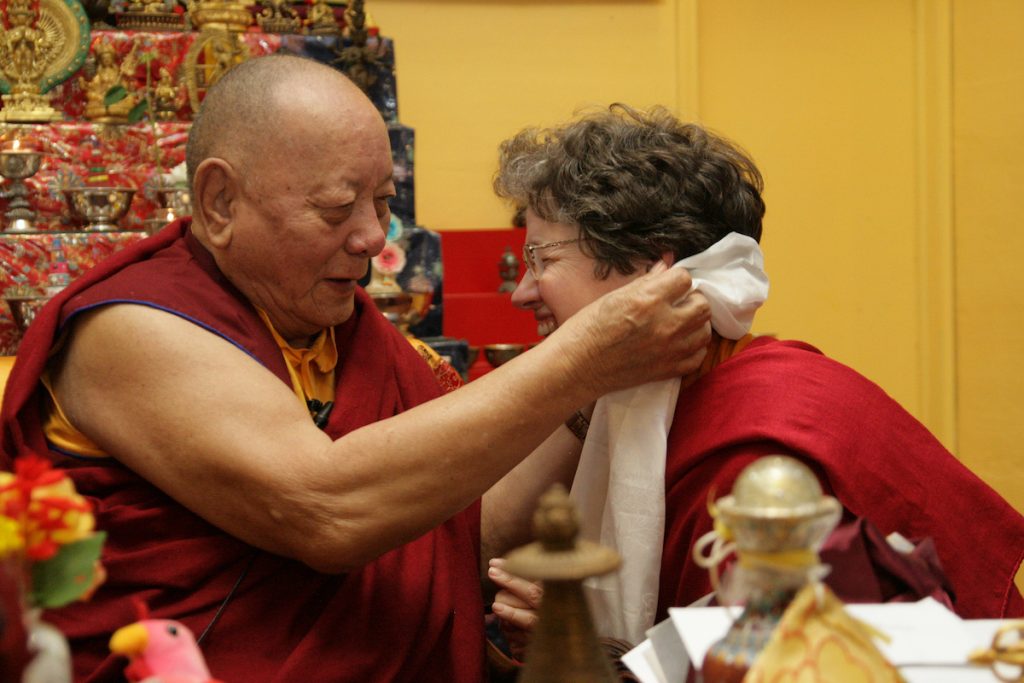Name: Columbus Karma Thegsum Chöling (KTC)
Resident Teacher: Lama Kathy Wesley
Established: 1977
Number of members: About 60
Meeting place: Currently without a home and working to rebuild
How did the Columbus Karma Thegsum Chöling (KTC) dharma center lose its home?
Lama Kathy Wesley: Since 1990, we met in an old wooden frame church in West Columbus. In the early morning hours of Sunday, January 31, 2016, an arsonist set seven fires in the alley’s trash bins. The roof instantly went up in flames, and the walls began to cave in, so the building was not salvageable. The arsonist fled but was arrested nearly a year later. [According to police reports, the arsonist claimed to have no knowledge that the building was a Buddhist temple. –The Eds.]

How has the sangha responded to this crisis?
We’ve never experienced anything like this. We’re learning a lot, especially that people in our community find Buddhism and meditation to be incredibly valuable to themselves and others. We didn’t know we had so many friends.
We are now meeting in a Jewish temple for our regular Tuesday night Chenrezi ceremony [a deity practice focused on the bodhisattva of compassion] and for our regular Sunday morning programs. We use various arts centers and other Buddhist centers for our Saturday programs, and so we’ve been able to continue without interruption, which we’re very proud of. You may sometimes have to look to find us, but we’re out there. What we’re doing now is continuing to raise money to reestablish our home.
What is the mission statement of Columbus KTC?
To provide for all levels of practitioners a respectful and open community for the study, practice, and activities of the Karma Kagyu tradition under the guidance of Karma Triyana Dharmachakra [a monastery in upstate New York] and His Holiness the 17th Gyalwa Karmapa Ogyen Trinley Dorje.
Who is the Karmapa, and what role does he play for Columbus KTC?
Tibetan Buddhism as a whole is about the connection between ancient lineages of practice that go all the way back to the Buddha. The main practice of the Karma Kagyu tradition, since the time of Tilopa—our very first master in the 900s CE—has been this deep, penetrating insight meditation called mahamudra. Mahamudra is taught from master to disciple in an unbroken line from Tilopa into Tibet, and from the Tibetan masters into the lineage of the reincarnate teacher known as Karmapa.

How was the center started?
Khenpo Karthar Rinpoche was sent to the United States in 1976 to help the 16th Karmapa establish a monastery in upstate New York. That same year he began teaching in Columbus, Ohio, and soon after established Columbus KTC in the name of the 16th Karmapa.
What does Columbus KTC offer in terms of practice and education?
Our main focus is helping people establish a daily practice. We offer a group introductory class to meditation every Sunday morning. We also have an eight-week introduction to Buddhism class.
After that, there is the mentorship program, which is a series of meetings with a meditation instructor who helps the student establish a daily meditation practice. The mentor also helps them get through their first Buddhist book.
And then, if people wish to learn mantra practice, we also offer mentorship in the practice of Chenrezi, Medicine Buddha, or Green Tara, all of which we do on a semi-regular basis at the center.

For newcomers, how do you explain the meaning and significance of high-level practices that use chanting and visualization?
There are many objects that you can place your attention on when you’re meditating. You can place your attention on the breath for breath awareness meditation, for instance, or you can place your attention on the compassionate response in tonglen meditation, where you imagine giving happiness to others and removing their suffering. But another object you could place your attention on is your own buddhanature [the potential for awakening] in the form of a visualized Buddha. We start out by saying that the visualization is a special object in that it reflects our inner buddhanature. So by meditating on a form of the Buddha, this helps to cultivate and nurture the buddhanature within us.
How did you encounter the Karma Kagyu practice lineage of Tibetan Buddhism?
About a year after I graduated from college, I had my first job working at a newspaper in a small town in east central Ohio. Khenpo Karthar Rinpoche came and gave a lecture at the yoga center in this little town called Newark. I interviewed him for the newspaper and asked him some personal questions about meditation, and I felt a strong affinity for what he was teaching and who he was as an individual. You could say that when I saw him, I knew what I wanted to be when I grew up. What I saw in his personality was a great gentility, matched by an immense spiritual strength that was all about ethics, morality, and compassion.
That was the first visit he made to central Ohio, which was September 1977. I took refuge that November and have been connected to the KTC center ever since.

What is unique about the way Ohioans approach dharma?
I think the people who I’ve encountered in Ohio are very practical and pragmatic. They’re not just merely interested in some kind of quick fix, but connecting to something that’s deep and transformative.
Learn more about Columbus Karma Thegsum Chöling
Tricycle wants to learn about your sangha! Write news@tricycle.org to be considered.
Thank you for subscribing to Tricycle! As a nonprofit, we depend on readers like you to keep Buddhist teachings and practices widely available.
